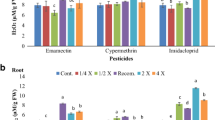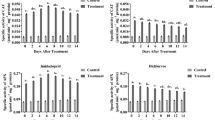Abstract
Tomato (Lycopersicon esculentum Mill.) becomes one of the world’s foremost vegetables, and its world production and consumption have increased fairly quickly. The capacity to induce oxidative stress in tomato plant, exposed to three xenobiotics such as alpha-cypermethrin, chlorpyriphos, and pirimicarb, was investigated by the evaluation of lipid peroxidation by measuring malondialdehyde (MDA) rate; also, we studied the response of tomato to this stress by assessing the response of superoxide dismutase (SOD), catalase (CAT), peroxidase (POD), ascorbate peroxidase (APX), glutathione-s-transferase (GST), and glutathione reductase (GR). The effect of the insecticides was observed using four concentrations (25, 50, 75, and 100 %) for germinating seeds and only the recommended concentration in agriculture (100 %) for growing plants. Our results show an important accumulation of MDA, demonstrating the increase of lipid peroxidation in consequence of the excessive reactive oxygen species (ROS) production due to insecticide treatment. In response to this oxidative stress in tomato seedlings and plants, the activities of antioxidant-enzyme system were generally enhanced. The electrophoretic analysis showed also the apparition of new isoenzymes as the case for CAT and POD.


Similar content being viewed by others
Abbreviations
- APX:
-
Ascorbate peroxidase
- CAT:
-
Catalase
- GR:
-
Glutathione reductase
- GST:
-
Glutathione-s-transferase
- MDA:
-
Malondialdehyde
- POD:
-
Peroxidase
- SOD:
-
Superoxide dismutase
References
Aeobi H (1974) Catalase: H.U methods of enzymatic analysis. Bergmayer, vol 2, Academic Press, pp 673–684
Arias-Estévez M, Lopez-Periago E, Martinez-Carballo E, Simal-Gandara J, Mejuto JC, Garcia-Rio L (2008) The mobility and degradation of pesticides in soils and the pollution of groundwater resources. Agric Ecosyst Environ 123:247–260
Arnon DI (1949) Copper enzymes in isolated chloroplasts, P-polyphénoloxidase in Beta vulgaris. Plant Physiol 24:1–13
Bartosz G (2003) The second face of oxygen. Warsaw: PWN. In: Song NH, Yin XL, Chen GF, Yang H (2007) Biological responses of wheat (Triticum aestivum) plants to the herbicide chlorotoluron in soils. Chemosphere 68:1779–1787
Bashir F, Uzzafar M, Siddiqi TO, Iqbal M (2007) The antioxidative response system in Glycine max (L.) Merr. Exposed to deltamethrin, a synthetic pyrethroid insecticide. Environ Pollut 147:94–100
Beauchamp C, Fridovich I (1971) Superoxide dismutase: improved assays and an assay applicable to acrylamide gels. Anal Biochem 44:276–287
Beyer WF, Fridovich I (1987) Assaying for superoxide dismutase activity: some large consequences of minor changes in conditions. Anal Biochem 161:559–566
Chagas RM, Silveira JAG, Ribeiro RV, Vitorello VA, Carrer H (2008) Photochemical damage and comparative performance of superoxide dismutase and ascorbate peroxidase in sugarcane leaves exposed to paraquat-induced oxidative stress. Pestic Biochem Physiol 90(3):181–188
Chahid K, Laglaoui A, Zantar S, Ennabili A (2013a) Effect of three insecticides on tomato (Solanum lycopersicum) seedling germination and early plants growth. Biol Divers Conserv 6/1:57–61
Chahid K, Laglaoui A, Zantar S, Ennabili A (2013b) Changes evaluation of reserve substances and degradation enzymes after exposure of tomato plants (Lycopersicon esculentum Mill.) to alpha-cypermethrin, chlorpyriphos and pirimicarb. ProEnvironment 6:33–41
Dixon DP, Cole DJ, Edwards R (1998) Purification regulation and cloning of a glutathione transferase (GST) from maize resembling the auxin-inducible type III GSTs. Plant Mol Biol 36(1):75–87
Drazkiewicz M, Skorzynska-Polit E, Krupa Z (2003) Response of the ascorbate/glutathione cycle to excess copper in Arabidopsis thaliana (L.). Plant Sci 164:195–202
Edwards R, Dixon DP (2005) Plant glutathione transferases. Methods Enzymol 401:169–186
Elstner EF (1990) Der Sauerstoff- Biochemie Biologie Medizin. BI-Wissenschaftsverlag, Mannheim. In: Mishra V, Srivastava G, Prasad SM, Abraham G (2008) Growth, photosynthetic pigments and photosynthetic activity during seedling stage of cowpea (Vigna unguiculata) in response to UV-B and dimethoate. Pesticide Biochemistry and Physiology 92:30–37
Foyer CH, Halliwell B (1976) The presence of glutathione and glutathione reductase in chloroplasts: a proposed role in ascorbic acid metabolism. Planta 133:21–25
Habig WH, Pabst MJ, Jakoby WB (1974) Glutathione S-transferases. The first enzymatic step in mercapturic acid formation. J Biol Chem 246:7130–7139
Health RL, Packer L (1981) Photoperoxidation in isolated chloroplastes. I. Kinetics and stoichiometry of fatty acid and peroxidation. Arch Biochem Biophys 125:189–198
Hossain MA, Asada K (1984) Inactivation of ascorbate peroxidase in spinach chloroplast on dark addition of hydrogen peroxide: its protection by ascorbate. Plant Cell Physiol 25:1285–1295
Jiang L, Yang H (2009) Prometryne-induced oxidative stress and impact on antioxidant enzymes in wheat. Ecotoxicol Environ Saf 72(6):1687–1693
Kishorekumar A, Abdul Jaleel C, Manivannan P, Sankar B, Sridharan R, Murali PV, Panneerselvam R (2008) Comparative effects of different triazole compounds on antioxidant metabolism of Solenostemon rotundifoliu. Colloids Surf B: Biointerfaces 62:307–311
McCord JM, Fridovich I (1969) Superoxide dismutase: an enzymic function for erythrocuprein. J Biol Chem 224:6049–6055
Michałowicz J, Posmyk M, Duda W (2009) Chlorophenols induce lipid peroxidation and change antioxidant parameters in the leaves of wheat (Triticum aestivumL.). J Plant Physiol 166:559–568
Mishra V, Srivastava G, Prasad SM, Abraham G (2008) Growth, photosynthetic pigments and photosynthetic activity during seedling stage of cowpea (Vigna unguiculata) in response to UV-B and dimethoate. Physiology 92:30–37
Mishra V, Srivastava G, Prasad SM (2009) Antioxidant response of bitter gourd (Momordica charantia L.) seedlings to interactive effect of dimethoate and UV-B irradiation. Sci Hortic 120:373–378
Mukesh J, Bhalla-Sarin N (2001) Glyphosate-induced increase in glutathione S-transferase activity and glutathione content in groundnut (Arachis hypogaea L.). Pestic Biochem Physiol 69:143–152
Peixoto F, Alves-Fernandes D, Santos D, Fontainhas-Fernandes A (2006) Toxicological effects of oxyfluorfen on oxidative stress enzymes in tilapia Oreochromis niloticus. Pestic Biochem Physiol 85:91–96
Putter J (1978) peroxydase. In: Bergmayer HU (ed) Methods of enzymatic analysis. vol 2, academic press, pp 685–690
Song NH, Yang ZM, Zhou LX, Wu X, Yang H (2006) Effect of dissolved organic matter on the toxicity of chlorotoluron to Triticum aestivum. Science 17:101–108
Song NH, Yin XL, Chen GF, Yang H (2007) Biological responses of wheat (Triticum aestivum) plants to the herbicide chlorotoluron in soils. Chemosphere 68:1779–1787
Statistica (1997) Statistica statsoft Inc. release 5.1. Tulsa, OK, USA
Teisseire H, Vernet G (2000) Is the “Diuron effect” due to a herbicide strengthening of antioxidative defenses of Lemna minor? Pestic Biochem Physiol 66:153–160
Wang ME, Zhou QX (2006) Effect of herbicide chlorimuron-ethyl on physiological mechanisms in wheat (Triticum aestivum). Ecotoxicol Environ Saf 64:190–197
Willekens H, Langebartels C, Tiré C, Van Montagu M, Inzé D, Van Camp W (1994) Differential expression of catalase gene Nicotiana plumbaginifolia (L). Proc Natl Acad Sci U S A 91:10450–10454
Woodbury W, Spencer AK, Stahmann MA (1971) An improved procedure using ferricyanide for detecting catalase isozymes. Anal Biochem 44:301–305
Wu GL, Cui J, Tao L, Yang H (2010) Fluroxypyr triggers oxidative damage by producing superoxide and hydrogen peroxide in rice (Oryza sativa). Ecotoxicology 19:124–132
Yin XL, Jiang L, Song NH, Yang H (2008) Toxic reactivity of wheat (Triticum aestivum) plants to herbicide isoproturon. J Agric Food Chem 56:4825–4831
Zhang JJ, Lu YC, Zhang JJ, Tan LR, Yang H (2014) Accumulation and toxicological response of atrazine in rice crops. Ecotoxicol Environ Saf 102:105–112
Zhou ZS, Huang SQ, Guo K, Mehta SK, Zhang PC, Yang ZM (2007) Metabolic adaptations to mercury-induced oxidative stress in roots of Medicago sativa L. J Inorg Biochem 101:1–9
Author information
Authors and Affiliations
Corresponding author
Additional information
Responsible editor: Philippe Garrigues
Rights and permissions
About this article
Cite this article
Chahid, K., Laglaoui, A., Zantar, S. et al. Antioxidant-enzyme reaction to the oxidative stress due to alpha-cypermethrin, chlorpyriphos, and pirimicarb in tomato (Lycopersicon esculentum Mill.). Environ Sci Pollut Res 22, 18115–18126 (2015). https://doi.org/10.1007/s11356-015-5024-3
Received:
Accepted:
Published:
Issue Date:
DOI: https://doi.org/10.1007/s11356-015-5024-3




